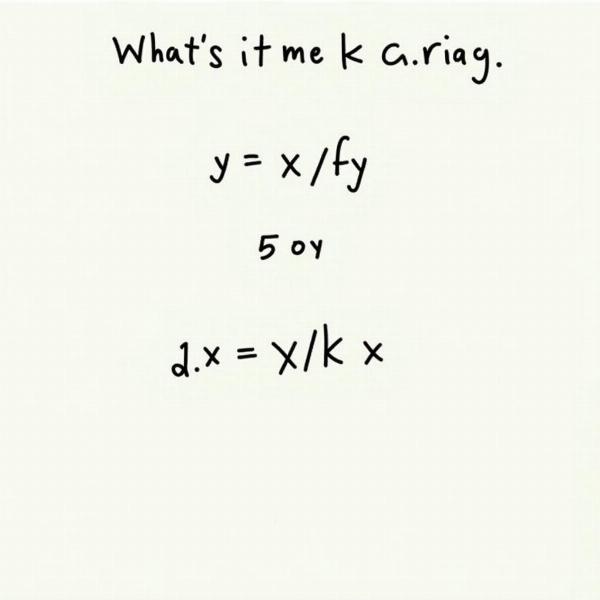Understanding the concept of “inversely proportional” is crucial in various fields, from physics and mathematics to economics and everyday life. If you’re seeking the meaning of inversely proportional in Hindi, you’ve come to the right place. This article will delve into the definition, provide Hindi translations, offer practical examples, and clarify common misconceptions.
What Does Inversely Proportional Mean?
Inverse proportionality describes a relationship where one quantity increases as another decreases, and vice versa. This relationship is not merely about one value going up while the other goes down, but about a specific, mathematically defined link. The product of the two quantities remains constant. If one quantity doubles, the other halves; if one triples, the other becomes one-third, and so on. This consistent inverse relationship is what distinguishes inverse proportionality from other types of negative correlations.
Inversely Proportional in Hindi: विपरीत आनुपातिक (Viparīt Ānupātik)
The Hindi phrase for inversely proportional is विपरीत आनुपातिक (viparīt ānupātik). विपरीत (viparīt) means opposite or inverse, while आनुपातिक (ānupātik) translates to proportional. Together, they accurately capture the essence of the English term. You might also encounter the term व्युत्क्रमानुपाती (vyutkramānupātī), which carries the same meaning.
Understanding Inverse Proportionality with Examples
Real-world scenarios can help solidify your understanding of inverse proportionality. Consider the relationship between speed and time taken to cover a certain distance. The faster you travel (increased speed), the less time it takes to reach your destination (decreased time). This is a classic example of inverse proportionality.
Another example can be found in the relationship between the price of a commodity and the quantity demanded. As the price of a product increases, the demand for that product typically decreases, assuming all other factors remain constant. This illustrates the principle of inverse proportionality in economics.
Inversely Proportional vs. Directly Proportional
It’s essential to distinguish between inversely proportional and directly proportional relationships. In a directly proportional relationship, both quantities increase or decrease together at a constant rate. For instance, the more hours you work (increased time), the more money you earn (increased earnings). This is the opposite of inverse proportionality.
How to Express Inverse Proportionality Mathematically
Mathematically, inverse proportionality is represented as:
y = k/x
Where:
- y and x are the two variables
- k is the constant of proportionality
This equation demonstrates the core principle: as x increases, y decreases, and their product (xy) always equals the constant k.
 Formula for inverse proportionality
Formula for inverse proportionality
Conclusion: Grasping the Essence of Inverse Proportionality
Understanding “inversely proportional,” or विपरीत आनुपातिक (viparīt ānupātik) in Hindi, is fundamental in various disciplines. From scientific principles to everyday observations, this concept plays a significant role. By grasping the mathematical relationship and exploring real-world examples, you can confidently apply this knowledge in your studies and daily life.
FAQ:
- What is the simplest way to identify an inversely proportional relationship? If one quantity goes up while the other goes down, and their product remains constant, it’s likely an inversely proportional relationship.
- Is inverse proportionality the same as a negative correlation? Not necessarily. A negative correlation simply means one variable tends to decrease as the other increases, but it doesn’t imply the specific constant product relationship of inverse proportionality.
- Can you give an example of inverse proportionality in physics? Boyle’s Law, which states that the pressure and volume of a gas are inversely proportional at a constant temperature, is a classic example.
- How is inverse proportionality used in everyday life? Understanding inverse proportionality can help you make decisions, such as choosing between driving faster to save time or slower to save fuel.
- What is the opposite of inversely proportional? Directly proportional.
- How do I calculate the constant of proportionality? You can find the constant (k) by multiplying the two variables (x and y) at any given point in the relationship.
- Is the graph of an inversely proportional relationship always a curve? Yes, it’s a hyperbola.
Meaning-Hindi.in offers professional translation services in a variety of specialized fields, including business and commerce, legal, technical, website localization, educational, and urgent translations. Our expertise ensures accurate and culturally sensitive translations between Hindi and other languages. Need help with translating complex technical documentation or legal contracts? Contact us at [email protected] or +91 11-4502-7584. Meaning-Hindi.in is your trusted partner for all your translation needs.